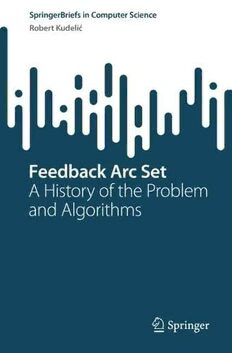Table Of ContentSpringerBriefs in Computer Science
Robert Kudelić
Feedback Arc Set
A History of the Problem
and Algorithms
SpringerBriefs in Computer Science
SeriesEditors
StanZdonik,BrownUniversity,Providence,RI,USA
ShashiShekhar,UniversityofMinnesota,Minneapolis,MN,USA
XindongWu,UniversityofVermont,Burlington,VT,USA
LakhmiC.Jain,UniversityofSouthAustralia,Adelaide,SA,Australia
DavidPadua,UniversityofIllinoisUrbana-Champaign,Urbana,IL,USA
XueminShermanShen,UniversityofWaterloo,Waterloo,ON,Canada
BorkoFurht,FloridaAtlanticUniversity,BocaRaton,FL,USA
V.S.Subrahmanian,UniversityofMaryland,CollegePark,MD,USA
MartialHebert,CarnegieMellonUniversity,Pittsburgh,PA,USA
KatsushiIkeuchi,UniversityofTokyo,Tokyo,Japan
BrunoSiciliano,UniversitàdiNapoliFedericoII,Napoli,Italy
SushilJajodia,GeorgeMasonUniversity,Fairfax,VA,USA
NewtonLee,InstituteforEducation,ResearchandScholarships,LosAngeles,CA,
USA
SpringerBriefs present concise summaries of cutting-edge research and practical
applicationsacrossawidespectrumoffields.Featuringcompactvolumesof50to
125pages,theseriescoversarangeofcontentfromprofessionaltoacademic.
Typicaltopicsmightinclude:
(cid:129) Atimelyreportofstate-of-theartanalyticaltechniques
(cid:129) A bridge between new research results, as published in journal articles, and a
contextualliteraturereview
(cid:129) Asnapshotofahotoremergingtopic
(cid:129) Anin-depthcasestudyorclinicalexample
(cid:129) A presentationofcoreconceptsthatstudentsmustunderstandinordertomake
independentcontributions
Briefsallowauthorstopresenttheirideasandreaderstoabsorbthemwithminimal
time investment. Briefs will be published as part of Springer’s eBook collection,
withmillionsofusersworldwide.Inaddition,Briefswillbeavailableforindividual
print and electronic purchase. Briefs are characterized by fast, global electronic
dissemination, standard publishing contracts, easy-to-use manuscript preparation
and formatting guidelines, and expedited production schedules. We aim for pub-
lication 8–12 weeks after acceptance. Both solicited and unsolicited manuscripts
areconsideredforpublicationinthisseries.
**Indexing:ThisseriesisindexedinScopus,Ei-Compendex,andzbMATH**
Robert Kudelic´
Feedback Arc Set
A History of the Problem and Algorithms
RobertKudelic´
FacultyofOrganizationandInformation
Science,TheoreticalandApplied
FoundationsofInformationScience
UniversityofZagreb
Varaždin,Croatia
ISSN2191-5768 ISSN2191-5776 (electronic)
SpringerBriefsinComputerScience
ISBN978-3-031-10514-2 ISBN978-3-031-10515-9 (eBook)
https://doi.org/10.1007/978-3-031-10515-9
©TheAuthor(s),underexclusivelicensetoSpringerNatureSwitzerlandAG2022
Thisworkissubjecttocopyright.AllrightsaresolelyandexclusivelylicensedbythePublisher,whether
thewhole orpart ofthematerial isconcerned, specifically therights oftranslation, reprinting, reuse
ofillustrations, recitation, broadcasting, reproductiononmicrofilmsorinanyotherphysicalway,and
transmissionorinformationstorageandretrieval,electronicadaptation,computersoftware,orbysimilar
ordissimilarmethodologynowknownorhereafterdeveloped.
Theuseofgeneraldescriptivenames,registerednames,trademarks,servicemarks,etc.inthispublication
doesnotimply,evenintheabsenceofaspecificstatement,thatsuchnamesareexemptfromtherelevant
protectivelawsandregulationsandthereforefreeforgeneraluse.
Thepublisher,theauthors,andtheeditorsaresafetoassumethattheadviceandinformationinthisbook
arebelievedtobetrueandaccurateatthedateofpublication.Neitherthepublishernortheauthorsor
theeditorsgiveawarranty,expressedorimplied,withrespecttothematerialcontainedhereinorforany
errorsoromissionsthatmayhavebeenmade.Thepublisherremainsneutralwithregardtojurisdictional
claimsinpublishedmapsandinstitutionalaffiliations.
ThisSpringerimprintispublishedbytheregisteredcompanySpringerNatureSwitzerlandAG
Theregisteredcompanyaddressis:Gewerbestrasse11,6330Cham,Switzerland
Foreword
Thefeedbackarcsetproblemisaoneofthequintessentialproblemsofalgorithmics
and,moregenerally,ofcomputerscience.Theproblemiseasilystated:foragiven
directedgraphG=(V,E),findthesmallestsubsetE(cid:2) ⊂EsuchthatG(cid:2) =(V,E\
(cid:2)
E ) is acyclic. The problem is well-known and has been investigated by the best
minds in computer science. It arises as a fundamental issue in many problems in
industry,fromcircuitdesigntologistics.Yet,theproblemhasprovenverydifficult
tosolve.
Over the last fifty years, methods to solve the feedback arc set problem have
spannedthelengthandbreadthofthetechniquesofcomputerscience:paradigmsof
graphalgorithms,well-designeddatastructures,optimizationviaintegerprogram-
ming, heuristics with proven performance guarantees, “soft computing” methods
suchasantalgorithms,andstochasticmethodssuchasMonte-Carloalgorithms.
TheauthorRobertKudelic´haspublishedpapersonseveraldisparateapproaches
tothefeedbackarcsetproblem.Hisbooktakesthereaderchronologicallythrough
the feedbackarc setliterature,andas suchitprovidesa historicalcompendiumof
techniquesincomputerscience.
Sydney,NSW,Australia PeterEades
January2022
v
Preface
As is true for any subject in science, there comes a time when one needs to look
back,andtakeagazeuponworkdonethusfar.Andifwearetochoosesuchatime
foraclassicalcomputerscienceproblemknownasfeedbackarcset(FAS),andmore
thanhalfa centuryhaspassedsince itsfledglingdays,thisis agoodtimeto work
onthatgaze.Ageneralintroductiontotheproblemwillbepresented,hardnessand
importancewillbeargued.Spanwillbegivenfromtheoriginandthename,through
problemdefinitionandvariousversions,allthe wayto thedualversionandalink
with the feedbackvertexset and the forcing problem—practicalrelevance will be
coveredaswell.
By building on that foundation,a review of the algorithms will be given, with
special emphasis on FAS. The goal of this review is to give both depth, through
coveringalgorithms,andbreath,throughspanninglifetimeoftheFASproblem.It
istheintentionthat,throughthisbook,anyinterestedpartywillbeabletoquickly
findrelevantinformation,fosteringbothlearningandresearch.1
Thereareanumberofpeoplethatwereofhelptomeduringpreparationofthis
book, and therefore a few words of gratitude are in order. I would like to thank
mycollegeforsuggestingthatthematerialwhichisfoundinthiswork,a workin
progressatthattime,wouldbeagoodfitforabook—theideaquicklygrewinmy
mind,andthepublisherwassoonfound.
IwouldalsoliketoexpressmysinceregratitudetoPeterEades,wellknownfor
hisexpertisein graphproblems,forbeingso kindandtakingthetime towritethe
forewordtothisbook.
1Onlinesupplementarymaterialisavailableat:https://cs.foi.hr/fas/book/.
vii
viii Preface
Aspecialappreciationwouldgotomyfatherforenablingmyacademiccareer.
Gratitudeisinorderforacolleagueofmine,NikolaIvkovic´,whowasveryhelpful
inacquiringanumberofpapersforme.AndIcan’tforgetWayneWheeler,forthe
supportandforbeingsuchanicepersontotalktoo,itwaswonderful.
Varaz˘din,Croatia RobertKudelic´
April2022
Contents
PartI OverviewofFindings
1 FeedbackArcSet............................................................. 3
1.1 TheProblemandtheName ........................................... 3
1.2 Origin .................................................................. 3
1.3 Description ............................................................ 4
1.4 LinearProgrammingFormulation .................................... 5
1.5 InherentlyHardtoSolve .............................................. 5
1.6 HardtoApproximatebyExtension .................................. 6
1.7 FeedbackArcSetandTournament ................................... 6
1.8 FeedbackArcSetandEulerianDigraph ............................. 7
1.9 SubsetFeedbackArcSet ............................................. 8
1.10 GraphBipartization ................................................... 8
1.11 MaximumAcyclicSubgraph—Dual ................................. 8
1.12 FeedbackArcandVertexSet ......................................... 9
1.13 TheForcingProblem ................................................. 10
1.14 PracticalRelevance ................................................... 10
References .................................................................... 12
PartII FeedbackArcSetandAlgorithmsThereof
2 IntroductoryRemarks....................................................... 17
2.1 Methodology .......................................................... 17
2.2 CitedLiterature ....................................................... 18
2.3 AbouttheHistory ..................................................... 18
3 PapersandAlgorithms...................................................... 19
3.1 OnDirectedGraphsandIntegerPrograms .......................... 19
3.2 MinimumFeedbackArcSetsforaDirectedGraph ................. 19
3.3 MinimumFeedbackArcandVertexSetsofaDirected
Graph .................................................................. 21
3.4 AHeuristicAlgorithmfortheMinimumFeedbackArcSet ........ 22
ix
x Contents
3.5 ABranchandBoundAlgorithmfortheAcyclicSubgraph ......... 24
3.6 AcyclicSubdigraphsandLinearOrderings .......................... 25
3.7 FindingaMinimumFeedbackArcSetinReducibleFlow
Graphs ................................................................. 27
3.8 AContractionAlgorithmforFindingSmallCycleCut-sets ........ 28
3.9 ApproximationAlgorithmsfortheMaximumAcyclic
Subgraph .............................................................. 29
3.10 ExactandHeuristicAlgorithmsfortheWeightedFAS ............. 30
3.11 Approximationfor ConcurrentFlow with Uniform
Capacities.............................................................. 31
3.12 MethodforFinding a MinimalFeedbackArc Set in
Digraphs ............................................................... 35
3.13 AFastandEffectiveHeuristicfortheFeedbackArcSet ........... 35
3.14 ApproximationsfortheMaximumAcyclicSubgraph .............. 36
3.15 AHeuristicfortheFeedbackArcSet ................................ 37
3.16 NewResultsontheComputationofMedianOrders ................ 40
3.17 Approx.MinimumFeedbackSets and Multi-Cutsin
Digraphs ............................................................... 42
3.18 AFastandEffectiveAlgorithmfortheFeedbackArcSet .......... 43
3.19 ComputingApproximateSolutionsofFSPsusingGRASP ........ 48
3.20 ANewRoundingProcedurefortheAssignmentProblem .......... 50
3.21 OnEnumeratingAllMinimalSolutionsofFeedback
Problems ............................................................... 51
3.22 CombinatorialAlgorithmsforFeedbackProblemsin
Digraphs ............................................................... 53
3.23 AContractionAlgorithmforFindingMinimalFeedback
Sets .................................................................... 54
3.24 ExactExp.AlgorithmsforVertexBipartizationandOthers ........ 56
3.25 ParameterizedAlgorithmsforFeedbackSetProblems ............. 57
3.26 Branch and Bound Algo. for Linear Ordering in
Tournaments ........................................................... 59
3.27 HowtoRankwithFewerErrors ...................................... 61
3.28 FeedbackArcSetinBipartiteTournaments ......................... 63
3.29 AggregatingInconsistentInformation:Rankingand
Clustering ............................................................. 66
3.30 MinimumFeedbackArcSetsinRotatorGraphs .................... 69
3.31 RankingTournaments:LocalSearchandaNewAlgorithm ........ 70
3.32 DeterministicPivoting for ConstrainedRankingand
Clustering ............................................................. 75
3.33 FasterFAST(FeedbackArcSetinTournaments) ................... 77
3.34 Fixed-Parameter Tractability Results for FSPs in
Tournaments ........................................................... 78
3.35 Fast Local Search Algorithm for Weighted FAS in
Tournaments ........................................................... 79
3.36 FasterAlgorithmsforFeedbackArcSetTournament ............... 80

